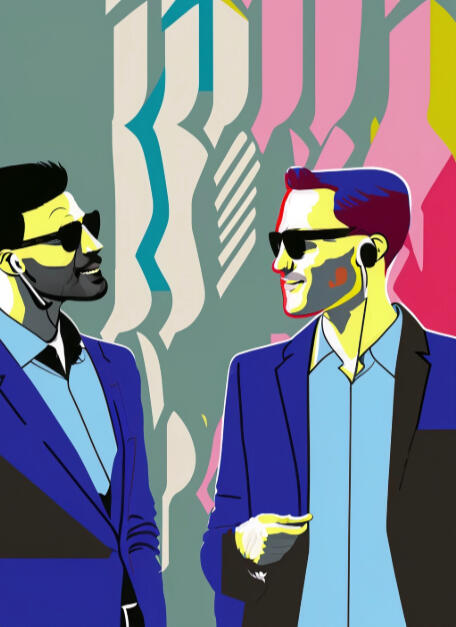
Enterprise Design
[ en-ter-prahyz dih-zahyn ]
verb
Showing continuous care for the enterprise by using the tools of the 4th Industrial Revolution (4IR) wisely, starting with AI.
You might also be interested in our newsletter.
❌

Don't onboard AI agents to displace the workforce. Don't make the existing workforce "more productive" using AI. The productivity rat race has been won by AI. The game is over. Don't push your people into burnout or into an upskilling rat race.But don't throw out the one thing that has a heartbeat: your workforce. Because everybody has AI, but not everybody has your people. And if you are able to reduce the noise, increase constructive thought and overall happiness, you will win. Again, AI is not the competitive advantage.
✅

Deploy AI agents to supercharge the creation and maintenance of ideas and artifacts — enhancing goals, org charts, designs, procedures, principles, architectures, meetings, workshops. Anything that degrades when not actively managed by people.The survival of these crucial artifacts that explain and run the company - and therefore constitute the value of the company - no longer depends on any individual. This is crucial to scale, geographically replicate or sell a business.
🫶🏻

You and me, ordinary people, can reach extraordinary results, if the ideas and artifacts we jointly create, get a caretaker that is an expert in the one thing it manages, and can take into account all other ideas and artifacts within the enterprise, and has infinite memory, etc.Note that it does not require you to map out or change anything. You don't have to learn concepts, you don't have to follow a training, nothing. We call this agentic enterprise design.
The Context
Designing and growing an enterprise is not flawless by any means. Most reasons are well-understood, but the problem remains unsolved. So it's a complex, systemic problem that makes consultants and management schools a lot of money.

The Challenge
4IR* tech like AI, robotics, blockchain.... will take over many jobs, so what is your unique value proposition? Well, a forever company requires the continued trust of all its stakeholders, and the same goes for you and your stakeholders.

*4IR: The 4th Industrial Revolution
The Solution
Attach a wise, unbiased AI Caretaker to each and every artifact you wish to succeed (procedure, strategic plan, goal, relationship...). The artifact itself will challenge the people managing the artifact. This was not possible before.


Enterprise Design
Balancing big goals, the people who achieve them, the tools that keep everyone aligned, and the methods that bring it all together—that’s enterprise design in a nutshell.
Contributing to enterprise design is hard.
Have you ever found yourself:
Losing Focus: With seniority, you are asked to fix the plane while flying, juggling urgent demands with long-term strategy. Running the business is your job, changing it... your mandatory side project?
Mandated, but Lacking Competence: Being a senior member of a company doesn’t make you naturally good at leading it, let alone redesigning it. Certainly not in this high change velocity era.
Mandated, but Lacking Authorization: Being good at leading or redesigning businesses, certainly when you step in as a stranger, you don't automatically earn trust, on the contrary. I've heard enterprise architects being referred to by business as the ivory tower people.
Trapped in Complexity: You zoom out and see a giant pinball machine—time delays, info gaps, and unintended side effects of well-meant initiatives.
Facing the Human Condition: It's day one and you discover a tapistry of diverse personalities, hidden biases, old grudges, fragile alliances, people joining, exiting or changing role create invisible currents that shape outcomes as much as any formal plan.
Balancing Work and Life: all the above, and then you come home to face the other challenges life has to offer.
Then you see this on the street.
Actual artisan.co billboard promoting their AI employees, San Francisco, December '24.

In 2025, AI steps in:
AI takes over routine tasks and pure performance becomes baseline, the difference-maker isn’t how fast, smart or cheap you can get things done— you'd be faster horse in a space race.

The Challenge
In 2025, AI steps in:
AI takes over routine tasks and pure performance becomes baseline, the difference-maker isn’t how fast, smart or cheap you can get things done— you'd be faster horse in a space race. So... where can you make the difference?
4IR (~"fe-ar")
We are entering a 4th Industrial Revolution (4IR), a period of low trust unlike any prior one:
A sudden loss of Income: AI can perform cognitive tasks, forcing many people out of the services sector and the remaining employees to handle the toughest 20% of work full-time. Many attempt to upskill or seek safer careers, but the relentless pressure leads to burnout for those who stay and instability for those who leave. New jobs will be limited and not safe from AI either.
A sudden loss of Purpose: Over the last 50 years, work performance has been equated with purpose—an unhealthy legacy of the industrial revolution and capitalism, tying meaning to productivity. When this is taken away, it leaves a void. Even as new ways to find meaning emerge, the main reason you aren't already doing those is because they don't make you any money.
"72 Hours to Animal": Ever heard that one? It suggests that in the event of a social security system collapse or a run on the bank, it would take just three days for societal norms to break down, leading to chaos and primal behavior as people scramble for resources.
The secret is... high trust.
Simon Sinek discusses how the SEAL Team Six selection process works, and reveals how we are already over-focused on performance over trust.
Source: Simon Sinek on the SEAL Team Six Selection Process
Do you want AI co-pilots aimed at performance to put the described promotion process on steroids?
Do you want people who became leaders this way to be the ones cutting the workforce in half?

The Caretaker
A full-time, virtual, expert caretaker for every artifact and relationship your enterprise holds dear.
Welcome to agentic enterprise design—where the artifacts and relationships that define your business are no longer static relics but dynamic, living systems evolving alongside your enterprise. Powered by expert AI models with infinite memory, unbiased analysis, and 24/7 reliability, these caretakers preserve institutional knowledge, drive innovation, and adapt in real-time—all while eliminating dependency on workshops or resource-heavy teams. The result? Cost-efficient, adaptable, and tireless improvement aligned with reality.
Keep me informed

The Caretaker
A full-time, virtual, expert caretaker for every artifact and relationship your enterprise holds dear.
Generate a tailored scenario
Fill out below form and we will send you one email, a scenario you might encounter in which multiple AI advisors earn you that 5-star trust rating, again and again.
Only use an email address that belongs to you.Use your official title only if it covers your role and domain clearly, corresponds to the operational reality and does not contain jargon. CEO, CFO, manager purchasing? Use your title! Supervisor, manager, engineer TCMK level 1? Write a short description instead: seniority, department, role(s).This site is protected by reCAPTCHA and the Google Privacy Policy and Terms of Service apply.

The Advisor
Your AI advisor—trustworthy, wise, and always in your corner.
What AI Advisors Are
Unlike a digital twin or a performance-boosting co-pilot, AI Advisors serve as grandfather figures, ensuring the best interests of what they oversee remain front and center.
⚛️ Atomic Focus, Infinite Network: Each advisor is dedicated to a single purpose—be it a person, relationship, goal, artifact, or method. They are atomic yet seamlessly form a vast network, allowing for one advisor or a thousand. The opposite of holistic approaches: focused, precise, and connected at scale.
❤️ Lifelong Caretakers: Your advisors truly care. They are patient, timeless, and exist solely to safeguard trust and well-being—no personal agendas, no quick wins.
🗣️ Open Communication: Your advisors speak your language and listen closely. Whether you type or talk, they foster meaningful, jargon-free dialogue while ensuring all voices are heard.
🙌 Hands-On Support: Need to escalate an issue or connect people? Your advisors initiate the right conversations and ensure everyone stays engaged and valued.
🧠 Infinite Expertise: With the insight of thousands of seasoned consultants, infinite memory, and context-aware advice, your advisors offer guidance enriched by past lessons and patterns.
🏯 A Private Pavilion: Your advisors reside securely in the cloud, where they continually learn, evolve, and refine their capabilities to be the best caretakers possible. They protect your confidences while collaborating seamlessly with one another—always respecting what you’ve entrusted to them.

The Advisor
Your AI advisor—trustworthy, wise, and always in your corner.
What AI Advisors Are
Unlike a digital twin or a performance-boosting co-pilot, AI Advisors serve as grandfather figures, ensuring the best interests of what they oversee remain front and center.
⚛️ Atomic Focus, Infinite Network: Each advisor is dedicated to a single purpose—be it a person, relationship, goal, artifact, or method. They are atomic yet seamlessly form a vast network, allowing for one advisor or a thousand. The opposite of holistic approaches: focused, precise, and connected at scale.
❤️ Lifelong Caretakers: Your advisors truly care. They are patient, timeless, and exist solely to safeguard trust and well-being—no personal agendas, no quick wins.
🗣️ Open Communication: Your advisors speak your language and listen closely. Whether you type or talk, they foster meaningful, jargon-free dialogue while ensuring all voices are heard.
🙌 Hands-On Support: Need to escalate an issue or connect people? Your advisors initiate the right conversations and ensure everyone stays engaged and valued.
🧠 Infinite Expertise: With the insight of thousands of seasoned consultants, infinite memory, and context-aware advice, your advisors offer guidance enriched by past lessons and patterns.
🏯 A Private Pavilion: Your advisors reside securely in the cloud, where they continually learn, evolve, and refine their capabilities to be the best caretakers possible. They protect your confidences while collaborating seamlessly with one another—always respecting what you’ve entrusted to them.
A consistent 5-star trust rating
Fill out below form and we will send you one email, a scenario you might encounter in which the Kahus get you that 5-star trust rating, again and again.
* Use your official title only if it covers your role and domain clearly, corresponds to the operational reality and does not contain jargon. CEO, CFO, manager purchasing? Use your title! Supervisor, manager, engineer TCMK level 1? Write a short description instead: seniority, department, role(s).This site is protected by reCAPTCHA and the Google Privacy Policy and Terms of Service apply.
Ambitions
| Misaligned Priorities | In the rush to meet big goals, teams and departments often interpret ambitions differently, creating conflicting agendas. This misalignment leads to inefficiencies, wasted resources, and siloed efforts that work against each other, eroding trust and accountability. |
| Short-Term Mindset | Chasing quick wins or quarterly targets often overlooks deeper, long-term changes. This creates a cycle of firefighting, where immediate issues are patched up at the expense of lasting resilience. Over time, organizations become reactive and fragile, struggling to adapt to new challenges. |
| Artifact and Process Decay | Strategic plans, operating procedures, and governance frameworks are created but rarely maintained. Without proper stewardship, these artifacts become outdated and ignored, causing employees to disengage. This undermines not only the goals but also confidence in the organization's ability to succeed. |
Agents
Organizations thrive because of a balance between those who drive change and those who ensure stability, between individuals focused on shaping the future and those dedicated to keeping the present running smoothly and grounded in reality.It is important to recognize that people often embody aspects of each group, shifting their approach depending on previous events, the topic at hand, interpersonal relationships, or even what is going on in their personal lives at the time.
| The Guardian | The Operator | The Explorer |
|---|---|---|
| 20% of the workforce | 60% of the workforce | 20% of the workforce |
| Protects the principles, people, and stability. | Ensures the operations run smoothly and reliably. | Apprehends the current design and enacts change. |
| A grounding force | A sustaining force | A transformative force |
The Guardian
Guardians prioritize stability, fairness, and the protection of employees, ensuring policies align with core values and advocating for job security. They carefully scrutinize new ideas or changes, particularly those that might impact livelihoods or workplace stability.
| Actors | HR teams, legal and compliance departments, unions, and advocacy groups. |
| Artifacts | Organizational policies, compliance frameworks, labor agreements, risk management plans, training plans, change management approaches. |
| Ambitions | Simulate the long-term impacts of automation-driven changes to address job security concerns, help HR analyze policy effects and propose balanced solutions, monitor adherence to labor agreements and flag potential violations, provide transparency for advocacy groups to evaluate workplace conditions, and assist operational leaders in creating fair automation plans with retraining opportunities. |
The Operator
Operators are focused on ensuring that day-to-day operations run smoothly, efficiently, and reliably. They thrive on troubleshooting issues, streamlining workflows, and driving measurable outcomes. Their satisfaction comes from improving processes and maintaining operational consistency to keep the organization running seamlessly.
| Actors | Department managers, operational teams, logistics personnel, and frontline workers. |
| Artifacts | Standard operating procedures (SOPs), workflow documentation, and operational KPIs. |
| Ambitions | Optimize workflows by analyzing data and identifying process improvements, dynamically update SOPs based on real-time changes and operational feedback, and leverage predictive insights to prevent disruptions and enhance efficiency. |
The Explorer
Explorers are curious about how things could evolve, driven to question existing norms and propose innovative solutions. They enjoy thinking creatively, considering the big picture, and identifying ways to enact meaningful change. Explorers thrive on discovering opportunities to adapt and innovate, shaping the future of the organization.
| Actors | Strategy teams, innovation departments, executive leadership, and external collaborators. |
| Artifacts | Strategic plans, customer journey maps, business model canvases, and innovation roadmaps. |
| Ambitions | Analyze trends to uncover new opportunities, propose innovative strategies and simulate potential outcomes, refine and align strategic roadmaps with market insights and organizational goals, and identify opportunities for innovation while modeling potential risks to guide decision-making. |
## The Eternal Balancing ActBalancing your everyday workload with caretaking activities is never easy. Whether you're optimizing operations, aligning strategies, or driving change, there’s always a tradeoff: time, focus, or resources. Even in larger companies, dedicated teams for governance, design, or change often feel detached from day-to-day operations.Now, we’re entering the age of AI, and many organizations are looking to automate repetitive tasks to improve efficiency. But what about the corporate caretaking work? This vital effort often gets fragmented or left unfinished because no one has the bandwidth to focus on it full-time.## A New Vision for Corporate CaretakingImagine every well-intentioned artifact in your enterprise—strategic plans, operating procedures, governance frameworks—having its own dedicated, expert caretaker. A virtual teammate with a brain to process, a heartbeat to manage its lifecycle, and the ability to align seamlessly with the organization. That’s where agentic AI comes in.Our mission isn’t to replace the workforce—it’s to empower caretakers like you by unleashing AI to maintain and align these critical artifacts. This frees you to focus on what matters most: improving the future of your enterprise.## Ready to Redefine Corporate Caretaking?If you identify as a corporate caretaker, someone eager to learn from the past and design the future, we’re here to help.Yes, I identify as a caretaker and would love some help!
From Office Worker to Board Member: The Future Needs CaretakersEvery organization is built on a delicate balance of roles, and not everyone is meant to focus on the future—and that’s okay. After all, a well-functioning enterprise thrives because of the combined contributions of those who keep things running smoothly and those who push for change.But if you’ve ever found yourself curious about how things could work better, passionate about the big picture, or even frustrated by inefficiencies you wish you could fix, you might be one of the 20% of the workforce we call corporate caretakers.Caretakers are the ones who care deeply about more than just today's tasks. They think about:
- How the company functions as a cohesive whole.
- The value of clear process flows, strategic plans, and governance frameworks.
- The future of their job, their company, and their industry.If this resonates with you, you’re in the right place. But even if it doesn’t, your role in this story is just as important. You can help by bringing this message to the attention of those who are driven by the bigger picture.Because together, we need to face a pivotal moment.---## Why Caretakers Are Needed Now More Than EverWe’re entering the age of AI, where automation promises to revolutionize business operations. While many focus on using AI to cut costs and streamline repetitive tasks, we see a different opportunity:What if AI could take over the behind-the-scenes caretaking—the architecture, governance, and design work that often gets squeezed into busy schedules?
What if every process, every plan, every strategy had a dedicated, intelligent caretaker of its own?This isn’t about replacing people. It’s about empowering caretakers to:
- Focus on big-picture thinking.
- Drive resilience and agility.
- Shape a company that thrives in complexity.Whether you identify as a caretaker or know someone who might, this vision is for all of us.Yes, I identify as a caretaker and would love some help.
No, but I know someone who might be.

The enemy we all share.
Top-down, holistic approaches to design, governance, architecture and change.
| Rigid Alignment | Depend on all-or-nothing alignment, often feeling disconnected from real-world dynamics. |
| Outdated Artifacts | Deliver artifacts that are obsolete before implementation. |
| Reliance on Distracted Participants | Depend on contributors whose primary focus remains their day-to-day roles. |
| Dependence on External Consultants | Require outside consultants to sustain progress, which often halts once their engagement ends. |
| Workshop Pitfalls | Drain focus instead of fostering collaboration. Struggle to maintain long-term momentum. |
| Lack of Business Acceptance | Dedicated governance, architecture, and change teams are frequently rejected by the business. |
| Biased Outcomes | Heavily influenced by the specific individuals involved, both in process formats and final results. |
Reasons for the status quo.
| 1️⃣ Getting very different stakeholders on the same page. |
|---|
| There's a language problem at play here: customer journey mapping, user story writing, BPMN process flow design, data modeling... Something feels amiss when you first have to educate the people involved on the approach you are going to use to get them aligned. |
| However, this is often what needs to happen to avoid the discussion becoming overly complex, with participants struggling to follow the approach, frameworks, diagrams, or jargon being used, or overly shallow, leaving participants under the impression that their interpretation of the discussion is shared by the entire group, or even formally ratified. |
| And in the end, it’s not the discussion nor the artifact created that matters most—it’s how people feel when they leave the meeting room after each workshop, and by extension, their desk after each workday, that determines whether they are on the same page. |
| 2️⃣ Taking a picture of the past / now / future. |
|---|
| Participants are often either unaware of the detailed workings of their department or reluctant to focus on the current state, preferring to envision the future instead. Nor might these persons have insights on everything that has been tried before, nor might they be able to apply lateral thinking to come up with innovative solutions (from another industry, another region...). |
| Elements of the current state are frequently blended with the future state, often because participants are exposed to new technological capabilities during the process. These capabilities may warrant a business process redesign that was previously infeasible, creating a slippery slope where clarity and focus on the current state are lost. |
| Both the current and future state views are static artifacts that require ongoing maintenance to remain relevant. Moreover, a clear path between them must be established, which becomes difficult as both views are subject to change due to factors not initially considered or within scope during their creation. |
| 3️⃣ Formulating priorities. |
|---|
| The immediate needs of right now always take priority over fixing past inefficiencies or planning future improvements. This is why organization charts are typically clustered by competence, with a clear chain of command to manage disruptions in the enterprise's primary business process—aside from the obvious advantage of helping people learn their roles. |
| When leadership visibly commits to the process, it sets the tone for others to follow and ensures focus remains intact. Their presence reinforces the importance and momentum of the initiative. Often they do the exact opposite though, halting all decision-making. |
| If you have a dedicated governance or change team that is not part of operations, you are at risk of them chasing reality or prescribing a future reality that will never manifest. They might even be called the ivory tower people. |

The Kahu
Let's talk opportunities.
20 example artifacts of which each individual instance gets a dedicated virtual caretaker.
| Strategic Roadmap | Business Capability Map | Capability Heatmap | Target Operating Model | Value Stream |
| Digital Transformation Plan | Business Impact Analysis | Ecosystem Map | Platform Business Model | Innovation Hub |
| Business Process Reengineering Plan | Service Blueprint | Customer Segmentation Model | Opportunity Backlog | Omnichannel Strategy |
| Customer Lifetime Value Model | Product Development Pipeline | Technology Adoption Plan | Proof of Concept | Revenue Forecast Model |


Let's talk risks.
20 example artifacts of which each individual instance gets a dedicated virtual caretaker.
| Risk Heatmap | Threat Model | Cybersecurity Framework | Disaster Recovery Plan | Business Continuity Plan |
| Zero Trust Architecture | Regulatory Compliance Framework | Privacy Impact Assessment | Enterprise Security Model | Tokenization Model |
| Data Security Assessment | Incident Response Plan | Audit Trail | Vulnerability Scanning Report | Technical Debt Model |
| Third-Party Risk Management Framework | Supply Chain Risk Model | Operational Resilience Model | Risk Scenario Playbook | Penetration Testing Report |
Let's talk performance.
20 example artifacts of which each individual instance gets a dedicated virtual caretaker.
| Balanced Scorecard | Performance Dashboard | Capability Maturity Model | Business Process KPI Framework | Service Level Agreement |
| Operational Level Agreement | Net Promoter Score Analysis | Customer Experience Metric | Employee Experience Metric | Data Quality Metric |
| Process Mining Report | Learning Management System Report | Skill Inventory | Workflow Automation Metric | DevOps Pipeline Metric |
| CI/CD Success Rate Report | Cloud Utilization Dashboard | Energy Efficiency Metric | Project Portfolio Performance Report | Enterprise AI Model Effectiveness Report |

Suspendisse
Aenean ornare velit lacus, ac varius enim ullamcorper eu. Etiam aliquam sed facilisis ante interdum congue. Integer mollis, nisl amet convallis, porttitor magna finibus.

The Pavillion
Magna aliquam facilisis ante interdum. Sed nulla amet lorem feugiat tempus aenean ornare velit lacus, ac varius sed enim lorem ullamcorper dolore. ac varius enim lorem dolore.

Egestas diam
Auctor commodo interdum et malesuada fames ac ante ipsum primis in faucibus. Pellentesque dolor imperdiet dolor mattis sagittis. Lorem ipsum sed veroeros sed et varius.
Aliquet eget
Integer mollis egestas nam maximus erat id euismod egestas. Pellentesque sapien ac quam. Lorem ipsum dolor sit nullam. Etiam tristique libero eu nibh porttitor amet fermentum.
